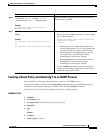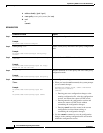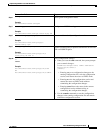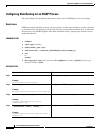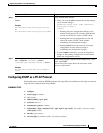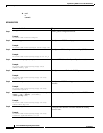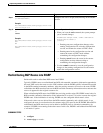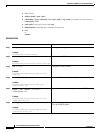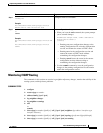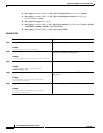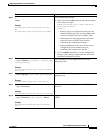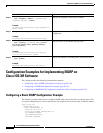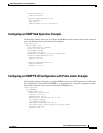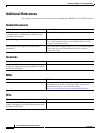
Implementing EIGRP on Cisco IOS XR Software
How to Implement EIGRP on Cisco IOS XR Software
RC-163
Cisco IOS XR Routing Configuration Guide
OL-14356-01
Monitoring EIGRP Routing
The commands in this section are used to log neighbor adjacency changes, monitor the stability of the
routing system, and help detect problems.
SUMMARY STEPS
1. configure
2. router eigrp as-number
3. address-family [ipv4 | ipv6]
4. log-neighbor-changes
5. log-neighbor-warnings
6. end
or
commit
7. clear eigrp [as-number] [vrf {vrf | all}] [ipv4 | ipv6] neighbors [ip-address | interface-type
interface-instance]
8. clear eigrp [as-number] [vrf {vrf | all}] [ipv4 | ipv6] topology [prefix mask] [prefix/length]
9. show eigrp [as-number] [vrf {vrf | all}] [ipv4 | ipv6] accounting
Step 7
default-metric bandwidth delay reliability
loading mtu
Example:
RP/0/RP0/CPU0:router(config-eigrp-vrf-af)#
default-metric 1000 100 250 100 1500
Configures metrics for EIGRP.
Step 8
end
or
commit
Example:
RP/0/RP0/CPU0:router(config-eigrp-vrf-af)# end
or
RP/0/RP0/CPU0:router(config-eigrp-vrf-af)#
commit
Saves configuration changes.
• When you issue the end command, the system prompts
you to commit changes:
Uncommitted changes found, commit them before
exiting(yes/no/cancel)?
[cancel]:
–
Entering yes saves configuration changes to the
running configuration file, exits the configuration
session, and returns the router to EXEC mode.
–
Entering no exits the configuration session and
returns the router to EXEC mode without
committing the configuration changes.
–
Entering cancel leaves the router in the current
configuration session without exiting or
committing the configuration changes.
• Use the commit command to save the configuration
changes to the running configuration file and remain
within the configuration session.
Command or Action Purpose



